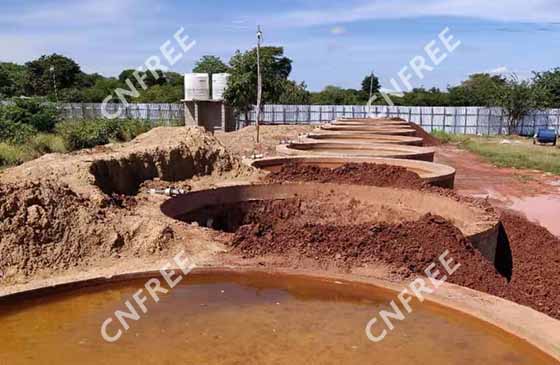2020-07-24 Views:3573
Warm Tip: If you want to know more information, like quotation, products, solutions, etc., please Click here ,and contact us online.

The process of extracting gold with cyanide as the leaching liquid is called gold cyanidation, and it is the main method for extracting gold from ore or concentrate in modern times.
However, cyanide waste water will become the main pollution source of water bodies, and the discharge of waste gas will cause direct harm to people and biological groups, and the dumping of waste residues will also cause deterioration of the ecological environment.
Therefore, we need to treat the tailings after gold extraction to eliminate the harm of cyanide, which is cyanide removal.
There are three main methods for cyanide removal, which are:
Volatilization method, biological decomposition method, photolysis method.
Alkaline chlorination method: chlorine method, hypochlorite method, electrolytic regeneration method;
SO2-air method;
Ozonation method;
Hydrogen peroxide method;
Acidification-volatilization-re-neutralization (AVR) method.
Ion exchange and acid regeneration method, ferrous sulfide method, ion flotation method, electrolysis method, transformation-precipitation method.
Alkaline chlorination refers to using chlorine gas or liquid chlorine and bleaching powder to oxidize cyanide in wastewater into non-toxic substances such as carbon dioxide and nitrogen. It is a commonly used method for treating cyanide-containing wastewater.
This method has good treatment effect, simple equipment and easy automation, but the reagent cost is high, cyanide cannot be recovered, and the treatment effect of ferricyanide complex is not good.
According to the different chlorine-based oxidants added, the alkaline chlorination method can be divided into bleaching powder method, liquid chlorine method, electrolytic salt method, etc. The advantages and disadvantages are shown in Table 1.
Table 1. The actual treatment methods of alkaline chlorination and their advantages and disadvantages
| Methods | Main Advantages | Main Disadvantages |
| Bleaching Powder Method |
1.Convenient management and good treatment effect; 2. After treatment, the effluent is clear. |
1. Difficulty in supply and storage of bleaching powder; 2. High processing cost; 3. There are many invalid waste residues in the bleaching powder. |
| Liquid Chlorine Method |
1. Good treatment effect 2. Convenient and storage and transportation; 3. After treatment, the effluent is clear and there is little sludge. |
1. Additional alkaline additives must be added; 2. Careless operation may cause poisoning accidents. |
| Electrolytic Salt Method | 1. Convenient management and good treatment effect 2. Less sludge; 3. More economical. |
1. Large power consumption; 2. Need to add salt electrolyte; 3. Long processing time. |
The ion exchange purification method is a method of removing harmful ions in wastewater by exchanging the ions in the wastewater with the exchange ions.
The advantage of the ion exchange purification method is that it can recover cyanide and metals, reduce cyanide and heavy metals to a very low level, and can remove bisulfate.
However, it also has some disadvantages, for example, HCN gas is dangerous, must be carefully sealed; the amount of sulfuric acid used for desorption is large; the resin bed may be blocked by metal precipitates; and the investment cost is relatively high.
Activated carbon adsorption catalytic oxidation method to treat cyanide-containing wastewater is a new method occurred in recent years. The use of activated carbon adsorption method to treat wastewater has low cost, and it can comprehensively recover valuable metals such as gold while removing cyanide in wastewater. The effect is very significant, which opens up a new way for the transformation from pure consumption sewage treatment to profitable sewage treatment.
The content of impurities such as copper, lead, zinc and chlorine in the treated wastewater is relatively small, and the drainage outside the tailings dam can be fully recycled, achieving a good effect of “zero discharge”. It can not only exempt the sewage discharge fee, but also save the cost of using fresh water, which solves the problem of water shortage.
There are many methods for cyanide removal in cyanide tailings of gold mines, but most of them require higher investment or advanced technology, and need to increase the investment in the gold cyanidation plant.
But there is a more convenient method that can save the process of cyanide removal, which is choosing eco-friendly agents for gold extraction. CNLITE gold dressing agent is such a eco-friendly agent. It can completely replace the role of cyanide in the gold cyanidation plant, and is low-toxic. It does not require harmless treatment of tailings, and can save big expenses for your gold cyanidation plant.
If you are interested in the methods and agents mentioned in this article, or want to discuss with us, please leave a message below or consult online customer service.
 +8618890227893
+8618890227893
 pinklaurabao@gmail.com
pinklaurabao@gmail.com
 No. 188, Xinhai Street, high-tech Industrial Park, Fushan District, Yantai, Shandong, China.
No. 188, Xinhai Street, high-tech Industrial Park, Fushan District, Yantai, Shandong, China.

TOP